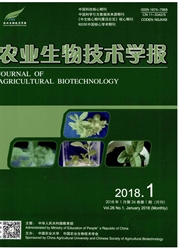

 中文摘要:
中文摘要:
辣椒(Capsicum annuum)胞质雄性不育可以被核内恢复基因恢复,然而人们对这些核内恢复基因的数量和作用方式仍然知之甚少。本研究利用QTL Ici Mapping作图软件构建了一张辣椒种内分子遗传图谱,利用该分子遗传图谱,共鉴定到与辣椒胞质雄性不育恢复性相关的2个主效QTL和7个微效QTL,2个主效QTL的遗传率高达92.58%。第1个主效QTL(q IF-3-1)可解释表型变异的46.68%,显性效应和加性效应分别为1.28和0.84。另1个主效QTL(q IF-5-1)可解释表型变异的47.10%,显性效应高达1.76。7个微效QTLs中,3个主要起加性效应,4个起显性效应。该结果不仅为开发辣椒胞质雄性不育恢复性的分子标记提供了指导,而且有助于深入了解辣椒胞质雄性不育育性恢复的调控机制。
 英文摘要:
英文摘要:
The fertility of cytoplasmic male sterility(CMS) can be restored by nuclear-encoded fertility restorer genes. However, the number and modifications of these restorer nuclear genes remain poorly understood. In this study, using QTL Ici Mapping software an intraspecific genetic linkage map of Capsicum annuum was constructed, and 2 major and 7 minor quantitative trait loci(QTLs) were identified, which acting as restorer-of-fertility(Rf) genes counteracting CMS. The heritability of the 2 major loci reached 92.58%. The first most important allele, q IF-3-1, contributed to fertility with a phenotypic variance explained(PVE) of46.68%, with dominant and additive effects of 1.28 and 0.84, respectively. The other major allele contributing to fertility, q IF-5-1, was associated with a PVE of 47.10% and improved fertility with higher dominant effects of 1.76. Among 7 minor QTLs, 3 QTLs mainly acted as additive effect, while another 4 as dominant effect.These results are beneficial for our understanding of the mechanisms regulating the function of Rf genes.Moreover, our results provide guidance for selecting molecular markers in the development of marker-assisted selection(MAS) fertility restoration breeding schemes in peppers.
 同期刊论文项目
同期刊论文项目
 同项目期刊论文
同项目期刊论文
 期刊信息
期刊信息
